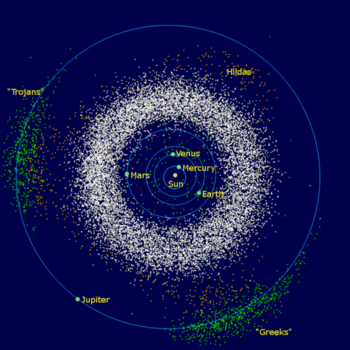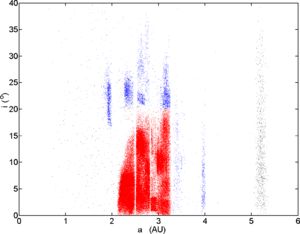主小行星帶:修订间差异
→環境: ,內容擴充 |
→環境: ,內容擴充 |
||
| 第172行: | 第172行: | ||
== 環境 == |
== 環境 == |
||
[[Image:Main belt e vs a.png|thumb|300px|right|以離心率顯示的小行星帶,主帶以紅色(核心)和藍色呈現。]] |
|||
儘管是群聚之處,小行星帶仍是非常的空曠。如果不是刻意的選定目標,太空船在穿越小行星帶時,在廣漠的太空中大的仍會一無所見。儘管如此,目前我們還是知道成千上萬的小行星,而總數可能高達數百萬顆或更多,就看我們如何界定小行尺寸的下限。在紅外線波段的巡天顯示,直徑在1 公里以上的小行星數量在700,000至1,700,000顆之間,而且還可能更多。<ref>{{cite journal |
|||
| author=Tedesco, E. F.; Desert, F.-X. |
|||
| title=The Infrared Space Observatory Deep Asteroid Search |
|||
| journal=The Astronomical Journal |
|||
| year=2002 |
|||
| volume=123 |
|||
| pages=2070–2082 |
|||
| url=http://www.journals.uchicago.edu/cgi-bin/resolve?id=doi:10.1086/339482 |
|||
| accessdate=2007-04-10 }}</ref> |
|||
在主帶內,直徑大於100[[公里]]的小行星超過200顆。<ref>{{cite web |
|||
| last = Yeomans |
|||
| first = Donald K. |
|||
| date = [[April 26]], [[2007]] |
|||
| url = http://ssd.jpl.nasa.gov/sbdb_query.cgi |
|||
| title = JPL Small-Body Database Search Engine |
|||
| publisher = NASA JPL |
|||
| accessdate = 2007-04-26 |
|||
}} — search for asteroids in the main belt regions with a diameter > 100.</ref> 在小行星帶內最大的天體是[[穀神星]],也是帶內唯一的[[矮行星]]。小行星帶的總值量估計是3.0-3.6{{e|21}} 公斤,<ref>{{cite journal| authorlink= Georgij A. Krasinsky | first=G. A. | last= Krasinsky | coauthors=[[Elena V. Pitjeva|Pitjeva, E. V.]]; Vasilyev, M. V.; Yagudina, E. I. | url=http://adsabs.harvard.edu/abs/2002Icar..158...98K| title=Hidden Mass in the Asteroid Belt| journal=Icarus| volume=158| issue=1| pages=98-105| month= July| year= 2002| doi=10.1006/icar.2002.6837}}</ref><ref>{{cite journal | last= Pitjeva | first=E. V. | authorlink= Elena V. Pitjeva | title= High-Precision Ephemerides of Planets—EPM and Determination of Some Astronomical Constants | journal= Solar System Research | year= 2005 | volume= 39 | issue= 3 | pages= 176 | url= http://iau-comm4.jpl.nasa.gov/EPM2004.pdf | format= [[PDF]] | doi= 10.1007/s11208-005-0033-2}}</ref> 這僅有[[地球]]衛星[[月球]]質量的4%,而穀神星就佔了其中的三分之一;11顆最大的小行星則佔有主帶內一半的質量。<ref name="mnras244">{{cite journal |
|||
| author=McBride, N.; Hughes, D. W. |
|||
| title=The spatial density of asteroids and its variation with asteroidal mass |
|||
| journal=Monthly Notices of the Royal Astronomical Society |
|||
| year=1990 |
|||
| volume=244 |
|||
| pages=513-520 |
|||
| url=http://adsabs.harvard.edu/abs/1990MNRAS.244..513M |
|||
| accessdate=2007-04-19 }}</ref> |
|||
{{TransH}} |
|||
The center of mass of the asteroid belt occurs at an orbital radius of 2.8 A.U.<ref name="mnras244" /> The large majority of the asteroids within the main belt have orbital [[eccentricity|eccentricities]] of less than 0.4, and an inclination of less than 30°. The orbital distribution of the asteroids peak at an eccentricity of around 0.07 and an inclination of under 4°.<ref name="mpc">{{cite web |
|||
| last = Williams |
|||
| first = Gareth |
|||
|date=[[April 3]], [[2007]] |
|||
| url = http://cfa-www.harvard.edu/iau/lists/MPDistribution.html |
|||
| title = Distribution of the Minor Planets |
|||
| publisher = Minor Planets Center |
|||
| accessdate = 2007-04-15 |
|||
}}</ref> Thus while a typical asteroid has a relatively circular orbit and lies near the plane of the [[ecliptic]], some asteroid orbits can be highly eccentric or travel well outside the ecliptic plane. |
|||
Sometimes, the term ''main belt'' is used to refer only to the more compact "core" region where the greatest concentration of bodies is found. This lies between the strong 4:1 and 2:1 [[Kirkwood gap]]s at 2.06 and 3.27 [[astronomical unit|A.U.]], and at [[eccentricity (orbit)|orbital eccentricities]] less than roughly 0.33, along with orbital [[inclination]]s below about 20°. This "core" region contains approximately 93.4% of all numbered minor planets within the Solar System.<ref name="basedon1"/> |
|||
The [[absolute magnitude]]s of most asteroids are 11–19, with the median at about 16.<ref name="mpc" /> By contrast, Ceres has a much higher absolute magnitude of 3.32.<ref>{{cite journal |
|||
| author=Parker, J. W.; Stern, S. A.; Thomas, P. C.; Festou, M. C.; Merline, W. J.; Young, E. F.; Binzel, R. P.; Lebofsky, L. A. |
|||
| title=Analysis of the First Disk-resolved Images of Ceres from Ultraviolet Observations with the Hubble Space Telescope |
|||
| journal=The Astronomical Journal |
|||
| year=2002 |
|||
| volume=123 |
|||
| pages=549–557 |
|||
| url=http://www.journals.uchicago.edu/cgi-bin/resolve?id=doi:10.1086/338093 |
|||
| accessdate=2007-04-15 }}</ref> The temperature of the asteroid belt varies with the distance from the Sun. For dust particles within the belt, typical temperatures range from 200 K (-73°C) at 2.2 A.U. down to 165 K (-108°C) at 3.2 A.U.<ref>{{cite journal |
|||
| author=Low, F. J. ''et al'' |
|||
| title=Infrared cirrus - New components of the extended infrared emission |
|||
| journal=Astrophysical Journal, Part 2 - Letters to the Editor |
|||
| year=1984 |
|||
| volume=278 |
|||
| pages=L19-L22 |
|||
| url=http://adsabs.harvard.edu/cgi-bin/bib_query?1984ApJ...278L..19L |
|||
| accessdate=2007-04-11 }}</ref> However, due to rotation, the surface temperature of an asteroid can vary considerably as the sides are alternately exposed to solar radiation and then to the stellar background. |
|||
{{TransF}} |
|||
=== 構造 === |
=== 構造 === |
||
=== 柯克伍德空隙 === |
=== 柯克伍德空隙 === |
||
{{main|柯克伍德空隙}} |
{{main|柯克伍德空隙}} |
||
[[Image:Kirkwood Gaps.png|300px|thumb|Distribution of asteroid [[semi-major axis|semi-major axes]] |
[[Image:Kirkwood Gaps.png|300px|thumb|Distribution of asteroid [[semi-major axis|semi-major axes]] |
||
== 家族和群組 == |
== 家族和群組 == |
||
{{main|小行星族}} |
{{main|小行星族}} |
||
2007年5月26日 (六) 02:12的版本

小行星帶是太陽系內介於火星和木星軌道之間的小行星密集區域,由已經被編號的120,437顆小行星統計得到98.5%的小行星都在此處被發現[1]。小行星是由岩石或金屬組成,圍繞著太陽運動的小天體。因為在比較上這是小行星最密集的區域,估計為數多達50萬顆,所以這個區域被稱為主帶,通常就直接稱為小行星帶。
小行星帶由原始太陽星雲中的一群星子—比行星微小的行星前身—形成。但是,因為木星的重力影響,阻礙了這些星子形成行星,並造成許多星子相互之間高能量的碰撞,於是清掃了這一區域,造成許多殘骸和碎片。小行星繞太陽公轉的軌道,繼續受到木星的攝動,形成了與木星的軌道共振。在這些軌道距離—柯克伍德空隙—上的小行星,會很快的被清掃入其他不同的軌道內。
在主帶內的質量都集中在幾顆最大的小行星上。在主帶內最大的三顆小行星是智神星、婚神星和灶神星,平均直徑都超過400 公里;在主帶中只有一顆矮行星—穀神星,直徑大約950 公里;其餘的小行星都不大,有些甚至小到只有塵埃的大小。小行星帶的物質非常稀薄,已經有好機艘太空船平安的通過而未曾發生意外。在主帶內的小行星依照它們的色彩和主要的形式分成三類:碳質、矽酸鹽和金屬。小行星之間的碰撞可能形成擁有相似軌道特徵和成色的小行星族,這些碰撞也是產生黃道光的塵土的主要來源。
觀測的歷史
在1781年發現天王星之後,波德就倡議在火星和木星軌道之間也許還有一顆行星。在1801年,矮行星穀神星就是在波德預測的軌道距離上發現的。 [2] 在1802年,天文學家奧伯斯發現了第二號小行星智神星,威廉·赫歇爾就建議這些天體是一顆行星被毀壞後的殘餘物。到了1807年,在相同的區域內又增加了第三顆婚神星和第四顆灶神星。[3] 由於這些天體的外觀像是恆星,威廉·赫歇爾就採用希臘文中的語根aster- (似星的)命名為asteroid,中文則譯為小行星。
拿破崙戰爭結束了小行星發現的第一個階段,[3] 一直到1845年才發現第五顆小行星義神星。緊接著,新小行星發現的速度快速增加,到了1868年中發現的小行星已經有100顆,而在1891年馬克斯·沃夫引進了天文攝影,更加速了小行星的發現。[4] 1923年,小行星的數量是1,000顆,1951年到達10,000顆,1982年更高達100,000顆。[5] 現代的小行星巡天系統使用自動化的設備使小行星的數量持續的增加。
在小行星發現後,必須要計算它們的軌道元素。在1866年,丹尼爾·柯克伍德宣布由太陽算起,在某些距離上是沒有小行星存在的空白區域,而在這些區域上繞太陽公轉的軌道週期與木星的公轉週期有簡單的整數比。柯克伍德認為是木星的攝動導致小行星從這些軌道上被移除。[6]
在1918年,日本天文學家平山清次注意到一些小行星的軌道有相似的參數,形成了小行星族。到了1970年代,觀察小行星的顏色發展出了分類的系統,三種最常見的類型是C-型(碳質)、S-型(矽酸鹽)和M-型(金屬)。[7]
在2006年,宣佈在小行星帶內發現了彗星的族群,而且建議這些彗星可能是地球上海洋中水的來源。在地球形成的過程中,本身並沒有足以形成海洋的水,因此需要一個外在的水源供應者—像一次彗星的轟擊是很有需要的。[8]
起源

目前被認同的行星形成理論是太陽星雲假說,認為星雲中構成太陽和行星的材料,塵埃和氣體,因為重力陷縮而生成旋轉的盤狀。[9]在太陽系最初幾百萬年的歷史中,因吸積過程的碰撞變得黏稠,造成小顆粒逐漸聚集形成更大的叢集,並且使顆粒的大小穩定的持續增加。一旦聚集到足夠的質量—所謂的微星 —便能經由重力吸引鄰近的物質。這些星子就能穩定的累積質量成為岩石的行星或巨大的氣體行星。
在平均速度太高的區域,碰撞會使星子碎裂而抑制質量的累積,[10]阻止了行星大小的天體生成。在星子的軌道週期與木星的週期成簡單整數比的地區,會發生軌道共振,會因擾動使這些星子的軌道改變。在火星與木星之間的空間,有許多地方與木星有強烈的軌道共振。當木星在形成的過程中向內移動時,這些共振軌道也會掃掠過小行星帶,對散布的星子進行動態的激發,增加彼此的相對速度。[11] 星子在這個區域(持續到現在)受到太強烈的攝動因而不能成為行星,只能一如往昔的繼續繞著太陽公轉,[12] 而且小行星帶可以視為原始太陽系的殘留物。
目前小行帶所擁有的質量應該僅是原始小行星帶的一小部分,以電腦模擬的結果,小行星帶原來的質量應該與地球相當。主要是由於重力的擾動,在百萬年的形成周期過程中,大部份的物質都被拋出去,殘留下來的質量大概只有原來的千分之一。[12]
當主帶開始形成時,在距離太陽2.7 AU之處形成了一條溫度低於水的凝結點線—"雪線",在這條線之外形成的星子就能夠累積冰。[13] 在小行星帶生成的主帶彗星都在這條線之外,並且是造成地球海洋的主要供應者。[14]
因為大約在40億年前,小行星帶的大小和分布就已經穩定下來(相對於整個太陽系),也就是說小行星帶的主帶在大小上已經沒有顯著的增減變化。[15]但是,小行星依然會受到許多隨後過程的影響,像是:內部的熱化、撞擊造成的熔化、來自宇宙線和微隕石轟擊的太空風化。因此,小行星不是原始的,反而是在外面古柏帶的小行星,在太陽系形成時經歷的變動比較少。
主帶的內側界線在與木星的軌道週期有4:1 軌道共振 的2.06 AU之處,[16],在此處的任何天體都會因為軌道不穩定而被移除。在這個空隙之內的天體,在太陽系的早期歷史中,就會因為火星(遠日點在1.67 AU)重力的擾動被清掃或拋射出去。
第五顆類地行星
一個早期的假說,早已經失寵的假說,認為小行星帶是一顆行星被摧毀後的殘骸。 在這個假說中有一些關鍵性的問題需要解決:第一,要摧毀一顆行星需要多大的能量?其次,目前小行星帶的總質量太低,比地球的衛星(月球)還要少!最後,小行星在化學成分上的歧異,很難解釋它們是否來自同一顆行星。[17]
也曾經有內行星中有第五顆類地行星的假說,但是軌道是不穩定的,因此他會穿越過小行星帶。穿越造成的結果是大量的小行星被從小行星帶拋出,然後這顆行星會被太陽吸收或是被拋出太陽系之外。[18]
環境

儘管是群聚之處,小行星帶仍是非常的空曠。如果不是刻意的選定目標,太空船在穿越小行星帶時,在廣漠的太空中大的仍會一無所見。儘管如此,目前我們還是知道成千上萬的小行星,而總數可能高達數百萬顆或更多,就看我們如何界定小行尺寸的下限。在紅外線波段的巡天顯示,直徑在1 公里以上的小行星數量在700,000至1,700,000顆之間,而且還可能更多。[19]
在主帶內,直徑大於100公里的小行星超過200顆。[20] 在小行星帶內最大的天體是穀神星,也是帶內唯一的矮行星。小行星帶的總值量估計是3.0-3.6×1021 公斤,[21][22] 這僅有地球衛星月球質量的4%,而穀神星就佔了其中的三分之一;11顆最大的小行星則佔有主帶內一半的質量。[23]
The center of mass of the asteroid belt occurs at an orbital radius of 2.8 A.U.[23] The large majority of the asteroids within the main belt have orbital eccentricities of less than 0.4, and an inclination of less than 30°. The orbital distribution of the asteroids peak at an eccentricity of around 0.07 and an inclination of under 4°.[24] Thus while a typical asteroid has a relatively circular orbit and lies near the plane of the ecliptic, some asteroid orbits can be highly eccentric or travel well outside the ecliptic plane.
Sometimes, the term main belt is used to refer only to the more compact "core" region where the greatest concentration of bodies is found. This lies between the strong 4:1 and 2:1 Kirkwood gaps at 2.06 and 3.27 A.U., and at orbital eccentricities less than roughly 0.33, along with orbital inclinations below about 20°. This "core" region contains approximately 93.4% of all numbered minor planets within the Solar System.[1]
The absolute magnitudes of most asteroids are 11–19, with the median at about 16.[24] By contrast, Ceres has a much higher absolute magnitude of 3.32.[25] The temperature of the asteroid belt varies with the distance from the Sun. For dust particles within the belt, typical temperatures range from 200 K (-73°C) at 2.2 A.U. down to 165 K (-108°C) at 3.2 A.U.[26] However, due to rotation, the surface temperature of an asteroid can vary considerably as the sides are alternately exposed to solar radiation and then to the stellar background.
構造
柯克伍德空隙
[[Image:Kirkwood Gaps.png|300px|thumb|Distribution of asteroid semi-major axes
家族和群組

新家族
| 这是一篇與天文學相關的小作品。你可以通过编辑或修订扩充其内容。 |
- ^ 1.0 1.1 這個數值是依據在2006年2月8日的資料小行星中心軌道資料
- ^ Staff. The Discovery of the Asteroid Belt. BBC. December 5, 2000 [2007-04-20].
- ^ 3.0 3.1 Staff. Astronomical Serendipity. NASA JPL. 2002 [2007-04-20].
- ^ Hughes, David W. A Brief History of Asteroid Spotting. BBC. [2007-04-20].
- ^ Yeomans, Donald K. JPL Small-Body Database Browser. NASA JPL. July 13, 2006 [2007-04-25]. — 小行星依照發現的順序編號。
- ^ Fernie, J. Donald. The American Kepler. The Americal Scientist. 1999, 87 (5): 398 [2007-02-04].
- ^ Finding Asteroids In Space. BBC. [2007-04-20].
- ^ Lakdawalla, Emily. 發現完整的新型態彗星. The Planetary Society. April 28, 2006 [2007-04-20].
- ^ Watanabe, Susan. Mysteries of the Solar Nebula. NASA. July 20, 2001 [2007-04-02].
- ^ Edgar, R.; Artymowicz, P. Pumping of a Planetesimal Disc by a Rapidly Migrating Planet (PDF). Monthly Notices of the Royal Astronomical Society. 2004, 354 (3): 769–772 [2007-04-16].
- ^ Scott, E. R. D. Constraints on Jupiter's Age and Formation Mechanism and the Nebula Lifetime from Chondrites and Asteroids. Precedings 37th Annual Lunar and Planetary Science Conference. League City, Texas: Lunar and Planetary Society. March 13-17, 2006 [2007-04-16].
- ^ 12.0 12.1 Petit, J.-M.; Morbidelli, A.; Chambers, J. The Primordial Excitation and Clearing of the Asteroid Belt (PDF). Icarus. 2001, 153: 338–347 [2007-03-22].
- ^ Lecar, M.; Podolak, M.; Sasselov, D.; Chiang, E. Infrared cirrus - New components of the extended infrared emission. The Astrophysical Journal. 2006, 640: 1115–1118 [2007-04-11].
- ^ Berardelli, Phil. Main-Belt Comets May Have Been Source Of Earths Water. Space Daily. March 23, 2006 [2007-04-11].
- ^ Stiles, Lori. Asteroids Caused the Early Inner Solar System Cataclysm. University of Arizona News. September 15, 2005 [2007-04-18].
- ^ Alfvén, H.; Arrhenius, G. The Small Bodies. SP-345 Evolution of the Solar System. NASA. 1976 [2007-04-12].
- ^ Masetti, M.; Mukai, K. Origin of the Asteroid Belt. NASA Goddard Spaceflight Center. December 1, 2005 [2007-04-25].
- ^ David, Leonard. Long-Destroyed Fifth Planet May Have Caused Lunar Cataclysm. Space.com. March 18, 2002 [2007-04-25].
- ^ Tedesco, E. F.; Desert, F.-X. The Infrared Space Observatory Deep Asteroid Search. The Astronomical Journal. 2002, 123: 2070–2082 [2007-04-10].
- ^ Yeomans, Donald K. JPL Small-Body Database Search Engine. NASA JPL. April 26, 2007 [2007-04-26]. — search for asteroids in the main belt regions with a diameter > 100.
- ^ Krasinsky, G. A.; Pitjeva, E. V.; Vasilyev, M. V.; Yagudina, E. I. Hidden Mass in the Asteroid Belt. Icarus. 2002, 158 (1): 98–105. doi:10.1006/icar.2002.6837. 已忽略未知参数
|month=(建议使用|date=) (帮助); - ^ Pitjeva, E. V. High-Precision Ephemerides of Planets—EPM and Determination of Some Astronomical Constants (PDF). Solar System Research. 2005, 39 (3): 176. doi:10.1007/s11208-005-0033-2.
- ^ 23.0 23.1 McBride, N.; Hughes, D. W. The spatial density of asteroids and its variation with asteroidal mass. Monthly Notices of the Royal Astronomical Society. 1990, 244: 513–520 [2007-04-19].
- ^ 24.0 24.1 Williams, Gareth. Distribution of the Minor Planets. Minor Planets Center. April 3, 2007 [2007-04-15].
- ^ Parker, J. W.; Stern, S. A.; Thomas, P. C.; Festou, M. C.; Merline, W. J.; Young, E. F.; Binzel, R. P.; Lebofsky, L. A. Analysis of the First Disk-resolved Images of Ceres from Ultraviolet Observations with the Hubble Space Telescope. The Astronomical Journal. 2002, 123: 549–557 [2007-04-15].
- ^ Low, F. J.; et al. Infrared cirrus - New components of the extended infrared emission. Astrophysical Journal, Part 2 - Letters to the Editor. 1984, 278: L19–L22 [2007-04-11].
